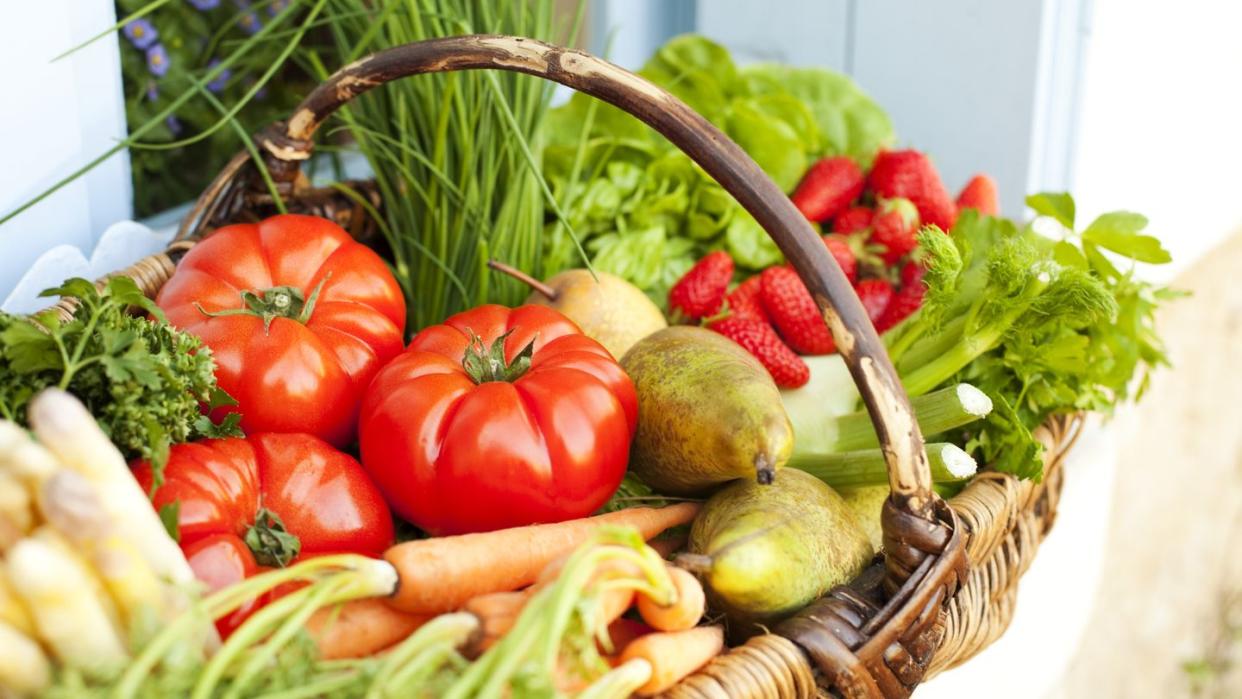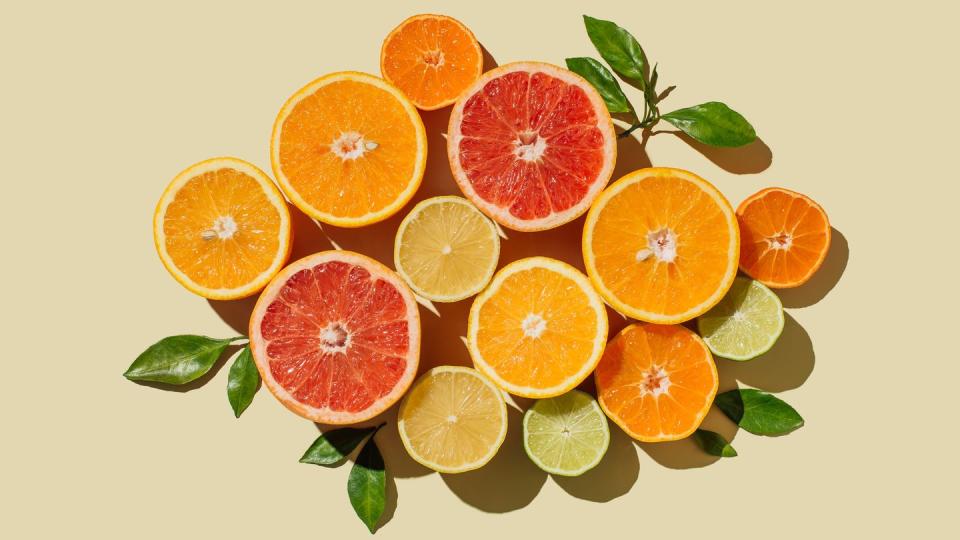The CDC Confirms The Healthiest Fruit In The World Isn't One You'd Expect

You know the drill: Eat your fruits and veggies! But the produce section is plentiful, and the farmers' market is bountiful, so which ones should you really focus on if you want to get the most bang for your buck, nutritionally speaking?
We were surprised to learn that one of the best veggies for you is watercress, according to the Centers for Disease Control and Prevention, which provides nutrition-density scores based on vitamin and mineral content in fruits and vegetables. Watercress, a peppery green that grows in freshwater and is a common ingredient in stir fries, scores a perfect 100. Veggies, overall, dominate the top of the list, which features greens like spinach (86) and kale (49), as well as other staples like red bell peppers (41) and broccoli (34).
But when it comes to fruit, the healthiest one is… the tomato. Yes, botanically speaking, tomatoes are considered fruit. They score a 20 on the CDC’s scale, just under carrots and right above lemons.
Tomatoes are packed with antioxidants, which you can think of as having a superhero-like function in your body, helping ward off free radicals that are known to cause oxidative stress and could play a role in the development of cancer, diabetes, heart disease, and other chronic conditions.
What Makes Tomatoes So Nutritious?

The CDC’s powerhouse fruit and vegetable categorization (PFV) is based on the amounts of 17 qualifying nutrients in a 100-calorie portion of each fruit and vegetable, explains dietitian Sherri Berger, RDN, from The Plant Strong Dietitian.
Since vegetables are naturally lower in calories than fruit, you would need to eat a much larger amount of vegetables than fruit to equal 100 calories, she says. Since a larger volume is going to pack in more nutrients, this would make the vegetables standout in the PFV scoring system.
Tomatoes, Berger explains, are a low-calorie fruit that have a similar nutrition profile to a vegetable. According to the U.S. Department of Agriculture’s nutrient database, a 60-gram plum tomato contains only 12 calories and less than three grams of carbohydrates. It’s also rich in the important nutrient lycopene, Berger says, which is what gives tomatoes their red color.
So, bring on the tomato-rich salsas and sauces!
“Eating tomatoes and tomato-based products can help protect your body from cancer and heart disease,” Berger says.
She also points to a 2021 umbrella study in the journal Food Chemistry that found tomato and lycopene consumption helps prevent coronary artery disease, gastric cancer, prostate cancer, and cerebrovascular disease, which affect blood flow to your brain like strokes or brain aneurysms.
Tomatoes are also rich in vitamins A and C, which combat inflammation in the body, explains dietitian Sara Riehm, R.D. with Orlando Health.
“Vitamin C is also important for forming blood vessels, muscles, and parts of our bones,” Riehm says. “Vitamin A is needed for eye health and growth and development.”
How Can You Get the Most Nutritional Benefits from Tomatoes?

Here's a general rule of thumb: “For most flavorful tomatoes, it’s best to buy them locally and keep them on your countertop,” Berger says. “Locally grown tomatoes are allowed to ripen naturally and do not undergo ethylene gas treatments which promotes artificial ripening.”
Also, opt for fully ripe tomatoes, as their lycopene content increases as they mature, says dietitian Kate Ingram, RDN, owner of The Vitality Dietitians.
“Cooking tomatoes can also boost lycopene, so consider adding tomatoes to cooked dishes like stews or making your own tomato sauce,” she says.
You can boost the absorption of lycopene by pairing tomatoes with healthy fats, such as olive oil, Ingram recommends.
What Other Fruits Are Considered the Healthiest?

Aside from tomatoes, here are five more fruits that make the cut as the most nutrient-dense, according to the CDC’s index.
Lemons
Lemons are very high in vitamin C, Riehm says.
“Unlike most animals, humans cannot produce their own vitamin C in the body,” she says. “This means we’re dependent on the Vitamin C we consume as food or drinks.”
Vitamin C can lower the risk of developing certain cancers, cardiovascular disease, and cataracts, Riehm explains.
The juice of lemons can be used in cooking to add extra flavor, prevent browning of apples and avocados, or to flavor to your water, she says.
But don’t go overboard: Due to the acidity of lemon flesh and juice, Riehm doesn’t recommend consuming whole lemons or large amounts of undiluted lemon juice. The acid can erode the enamel on our teeth and cause upset stomachs.
Oranges
Like lemons, oranges are high in vitamin C. They also contain small amounts of vitamin B6, which is needed for brain health, as well as potassium, which supports kidney, heart, and nerve function, and calcium, which you need for strong, healthy bones, Riehm explains.
To get the most nutritional benefits from oranges, skip the OJ and eat the fruit whole. It’s digested slower that way thanks to the fiber they contain, she explains.
Strawberries
In addition to vitamin C, strawberries also contain anthocyanin, a phytochemical that gives the fruit its color and acts as an antioxidant.
“The antioxidative properties of strawberries have been shown to play an important role in brain health,” Riehm says. “They protect the brain’s ability to think and process information. They can also delay or prevent the development of Alzheimer’s disease.”
If you can, buy organic strawberries, and add them to your cereal or yogurt. Otherwise, non-organic strawberries are known to retain some of the pesticides used to protect them during the growing process.
Limes
Like all citrus fruits, limes are excellent sources of vitamin C, Riehm says. The two main varieties of limes, Tahitian and Key, can be used in many ways—cooking, baking, as garnishes, you name it.
To get the most juice out of your lime, roll on a firm, flat surface before squeezing. As with lemons, I don’t recommend consuming raw limes or large amounts of undiluted lime juice due to the high acid content of the fruit.
Grapefruits
Grapefruits are high in vitamin C, vitamin A, and folate, Riehm says, which is important for healthy cell growth.
To get all the benefits of the fruit, she recommends eating raw grapefruits since the fiber and flesh is removed from juices.
“Grapefruits contain soluble fiber which has been shown to help manage blood sugars, cholesterol, and digestive health,” she says.
One important thing to note: While grapefruits are nutritious, be sure to talk to your doctor before including them in your diet. Grapefruits and their juice can interact with several types of medications, Riehm says.
Should You Prioritize Certain Fruits?
When it comes to fruits and veggies, dietitians generally encourage you to consume a wide variety to get the vitamins and minerals you need. Yes, some may have more nutrients, but that shouldn’t limit you.
“Each color group of produce has different nutrients, so eating the rainbow is very important,” Riehm says.
You Might Also Like

